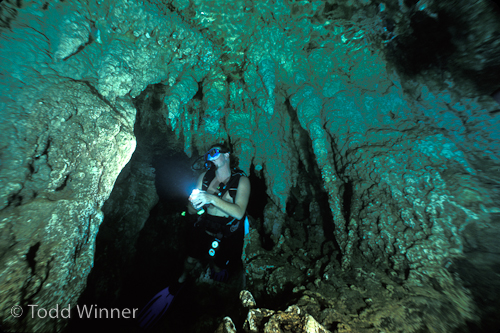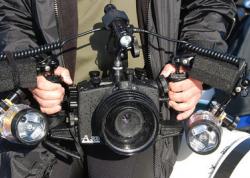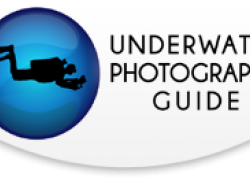Lessons learned - dive safety
Big lessons learned, almost the hard way.
An underwater photographer's close call diving the Chandelier Caves, Palau
By our nature, underwater photographers are thrill seekers and perhaps more adventurous than the average tourist. We will often almost forget that we are in a hostile, potentially lethal environment, while in pursuit of new experiences and that next great photograph. My wife and I were diving with friends on a multi-day liveaboard in Palau a number of years ago, when we participated in a nearly catastrophic dive. We learned a number of things that day.
Introducing the Dive
Chandelier Caves is a very interesting, “intermediate” level cave dive. Following a very long, 1-1/2-2 hour third dive at “Mandarin Lake” for underwater photography, our very experienced, self-assured dive guide told us that he could show us a really great dive that was an easy way to see an underwater cave system with large, air-filled rooms and stalactites. Our guide was so sure of the ease and safety of the dive, he thought we didn’t even need to refill our partially empty tanks. Fortunately, we all demanded full tanks and got them. The caves are entered through a large opening at about 15- 20’ that leads to a very large room.
An enjoyable start taking underwater photos
We surfaced and took photos of the stalactites and then proceeded to the next smaller, but more spectacular second room. Each room is connected to the large tunnel, starting at the entrance and continuing at about 15 to 25 feet deep to include 4 rooms, each one smaller than the last. After enjoying the amazing place we found ourselves in, we continued on to the third room, smaller still and ultimately to a fourth room, which was very small and humid; maybe 20’ x 20’.

Rocky island shoreline, nearby the entrance of the Chandelier caves in Palau
Risky Adventures
Our guide then challenged us to ditch our SCUBA gear and go spelunking in another cave system above the water line. After removing our dive gear and leaving it with my wife and one other friend, three of us followed our guide into a very slippery, hot, humid room filled with stalactites and many ways to slip and fall and break a leg. Should any of us had fallen and gotten injured, climbing back, gearing back up and SCUBA diving back out could have been very difficult, if not impossible.
When we returned to the fourth room, legs intact, my wife and one friend who remained with the gear were obviously ready to go. We struggled to get in our gear…remember, this is in a pitch black, small, claustrophobic space and we had been exerting all day, especially after just finishing a tricky climb through the muddy cave system. Our guide got tangled in his BC and gear hose and I dropped my mask into the shallow, but murky pool. By the time we were geared up, we were also a little keyed up to get out, to say the least.
Our guide dropped down and we followed his dive light. After a number of minutes of swimming we surfaced into the third room. It was obvious that our guide was uncomfortable. The problem was that he was used to navigating by the light coming in from the entrance. You literally were looking for the light at the end of the tunnel.
We had entered the cave system much later in the day than was usual; we had spent a long time taking pictures and the spelunking add-on put us in the caves well after sunset. Once again we dropped down and swam for what seemed like a long time only to resurface in the third room again.

After diving underwater in the Chandelier Caves
The Big Problem
Now it was getting “interesting”. Once again, our guide dropped down to get his bearings. We decided to stay put and conserve our dwindling air supply (and to calm down). When he returned he said to follow him and “hurry”, which didn’t make me feel any better. We swam for at least 10 minutes, frantically kicking as hard as we could to stay within sight our our fast swimming, nervous guide.I started thinking that this is how accidents happen and made a big effort to control my breathing as I started to think about alternate ways to approach our problem, should our guide lose us in his hurry to get out.
When we resurfaced, we found ourselves in the second room. Progress! After a very brief wait, we again dropped down and swam for a long time. Expecting to surface in the first room, you can imagine our feelings when we popped up in the tiny fourth room again.
Now it was obvious that we had a big problem. We all started talking and everyone had a sick look on his face.
Getting Out
Instead of trying to reassure us that all was okay, our now obviously clueless guide said “Shit! I’m disoriented. I can’t believe how disoriented I am.”1 He started down again, when we stopped him and tried to calm him down. Fortunately, I thought of our compasses and asked him if he knew the heading out. Duh! He said yeah and we then slowly, anxiously worked our way back to the first room. I can remember, like it was yesterday, the sight of the boat’s dive ladder and a nearly full moon in the sky as we exited the mouth of the cave system and indeed found the light at the end of the tunnel.
Lessons learned for underwater photographers
There are many lessons to be learned from this:
First, do not put all your faith in anyone else to keep you safe during a dive. We literally put our lives in the hands of an eager, but incompetent dive guide2, who very nearly led us to disaster.
Second, don’t put yourself in any situation that you cannot safely get yourself out of.
Third, always stay calm and take the time to find a solution to your problem.
Fourth: think twice about pushing the envelope to get that really great shot or experience that really great thing. Plan your dive and dive your plan, as they say.
Footnotes:
About the Author
This is the first of a series of monthly columns written by Underwater Photography Guide field editor Randy Harwood. Visit Randy's website or email him.

RECOMMENDED ARTICLES
SUPPORT THE UNDERWATER PHOTOGRAPHY GUIDE:
The Best Service & Prices on u/w Photo Gear
 Visit Bluewater Photo & Video for all your underwater photography and video gear. Click, or call the team at (310) 633-5052 for expert advice!
Visit Bluewater Photo & Video for all your underwater photography and video gear. Click, or call the team at (310) 633-5052 for expert advice!
The Best Pricing, Service & Expert Advice to Book your Dive Trips
 Bluewater Travel is your full-service scuba travel agency. Let our expert advisers plan and book your next dive vacation. Run by divers, for divers.
Bluewater Travel is your full-service scuba travel agency. Let our expert advisers plan and book your next dive vacation. Run by divers, for divers.































